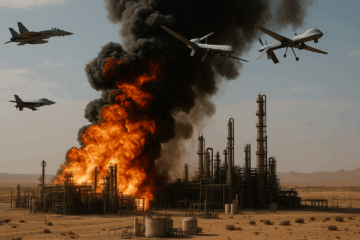The recent allocation of $409 million in funding by the United States Air Force (USAF) to revitalize an airfield on the island of Tinian signifies a definitive long-term investment and commitment to American deterrence throughout the Indo-Pacific region. The history of the United States military’s affiliation with Tinian is closely tied to the island’s strategic importance during World War II. Prior to the war, Tinian, along with the rest of the Mariana Islands, was under Japanese control. Japan established military installations on the island, including airfields and defensive fortifications, as part of its efforts to expand influence across the Pacific.
Throughout World War II, Tinian became a key battleground between American and Japanese forces. In 1944, the United States launched Operation Forager, a campaign to capture the Mariana Islands, including Tinian, from Japanese control. The Battle of Tinian, which lasted from July 24 to August 1, 1944, resulted in a decisive American victory, with the island ultimately falling under American control.
Following its capture, Tinian was transformed into a major strategic military base for the United States. The United States Army Corps of Engineers quickly began construction of airfields and other infrastructure to support American operations throughout the Pacific theater with Tinian’s airfields, particularly North Field and West Field, becoming vital launching points for American bombing raids against Japanese targets during the final stages of World War II. It was from Tinian that the Boeing B-29 Superfortress bombers Enola Gay and Bockscar took off to drop atomic bombs on Hiroshima and Nagasaki, hastening the end of World War II in the Pacific theater.
Beyond the successful termination of World War II, Tinian remained under American control as part of the Trust Territory of the Pacific Islands, which was administered by the United States. The island’s military installations were maintained and utilized for various purposes, including training exercises, logistics support, and surveillance activities during the Cold War.
In the modern era, Tinian continues to host military activities, although on a smaller scale. The island’s airfields are still used for military and civilian flights, and the United States maintains a presence in the region to support its security interests in the Pacific.
Overall, the history of American military affiliation with Tinian reflects the island’s strategic significance as a key outpost in the Pacific theater during World War II and its continued importance in maintaining American military presence and influence in the region.
Tinian’s location in the Pacific makes it strategically important for maintaining a presence in the region. It provides a strategic foothold for the United States in the western Pacific, enabling rapid response to regional security challenges and ensuring stability.
With the growing focus on the Indo-Pacific region, Tinian offers a base from which the US can conduct military exercises, patrols, and operations in theater. This enhances America’s ability to deter potential adversaries and protect its interests in the region.
Tinian’s infrastructure, particularly its ports and airfields, also support military operations and logistics in the Pacific. It serves as a hub for resupplying and refueling military assets and facilitating the movement of troops and equipment across the region.
Tinian’s strategic value extends beyond its physical attributes. It also plays a role in strengthening alliances and partnerships with regional allies, such as Japan and South Korea, by demonstrating American commitment to regional security and stability. Though Tinian played a vital role in supporting American interests for decades, re-establishing a strategic airfield on Tinian Island presents several challenges for the United States.
First, Tinian’s existing infrastructure needs significant upgrades and expansion to accommodate American bombers. This includes runways, taxiways, hangars, fuel storage facilities, and other support infrastructure. Constructing and maintaining these facilities is costly and time-consuming.
Given the emphasis on eco-friendly sustainability, Tinian’s diverse ecosystems, including coral reefs, coastal forests, and wetlands are a possible challenge to military expansion. Establishing a large airfield could have adverse effects on these environments, potentially leading to habitat destruction, pollution, and other environmental impacts. Mitigating these concerns, while developing the airfield, is essential to minimizing negative cultural and socio-political consequences that have the potential to impact foreign relations.
Locally, some residents of Tinian and nearby islands may oppose the establishment of a strategic airfield due to concerns about noise, increased military presence, and potential disruptions to their way of life. Addressing these concerns and gaining local support for the project is crucial for its near- and long-term viability. The process of acquiring land and securing necessary permits for the airfield may involve navigating complex political and legal landscapes, both locally and internationally. Cooperation with the local government of the Northern Mariana Islands and adherence to relevant laws and regulations are essential for a smooth and lawful development process.
Furthermore, establishing a strategic airfield on Tinian Island requires ensuring its security against potential threats, including military aggression, terrorism, and espionage. Implementing robust security measures, such as perimeter fencing, surveillance systems, and military patrols, is necessary to safeguard the airfield and its operations. Establishing a comprehensive force protection plan designed to deter and mitigate external and internal threats is challenging for a geographically isolated operational installation.
Logistically, maintaining a strategic airfield on Tinian requires adequate support, including transportation of personnel, equipment, and supplies. Ensuring reliable access to these resources, particularly in remote island locations, is challenging and may require coordination with military and civilian logistics providers with the capabilities to provide operational and contingency logistical support.
Addressing these challenges requires careful planning, coordination, and cooperation between various stakeholders, including the United States military, local government, environmental agencies, and the civilian population. Despite the obstacles, the strategic value of establishing an airfield on Tinian outweighs the challenges, given its importance for projecting American military power and political influence in the Pacific region.
Tinian stands as a critical asset in the United States’ deterrence strategy in the Indo-Pacific region, offering strategic advantages that enhance American military presence and projection capabilities. Its historical significance, particularly as a pivotal base during World War II, underscores its enduring importance in shaping regional security dynamics.
While Tinian holds immense strategic value, its development as a key military outpost presents a myriad of challenges. From the need for significant infrastructure upgrades to addressing environmental concerns and local opposition, establishing and maintaining a strategic airfield on Tinian requires careful planning, coordination, and cooperation among various stakeholders.
Despite these challenges, the strategic imperatives driving the United States’ presence on Tinian Island are clear. As geopolitical dynamics in the Indo-Pacific region continue to evolve, Tinian’s role as a forward-operating base for American forces remains indispensable for deterring potential adversaries, safeguarding regional stability, and protecting vital national interests.
Joshua Thibert is a Contributing Senior Analyst at the National Institute for Deterrence Studies (NIDS). With over 30 years of comprehensive expertise, Joshua’s background encompasses roles as a former counterintelligence special agent within the Department of Defense and as a practitioner in compliance, security, and risk management within the private sector. The views expressed in this article are the author’s own.
About the Author

Joshua Thibert
Joshua Thibert is a Contributing Senior Analyst at the National Institute for Deterrence Studies (NIDS)with over 30 years of comprehensive expertise, his background encompasses roles as a former counterintelligence special agent within the Department of Defense and as a practitioner in compliance, security, and risk management in the private sector. His extensive academic and practitioner experience spans strategic intelligence, multiple domains within defense and strategic studies, and critical infrastructure protection.




